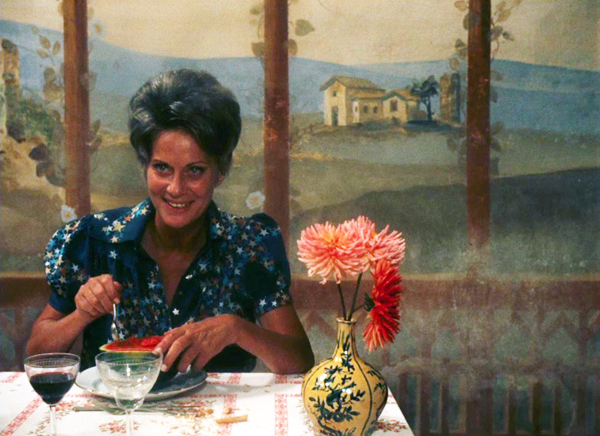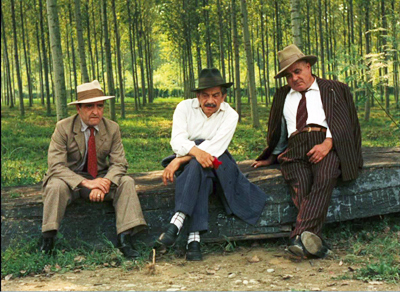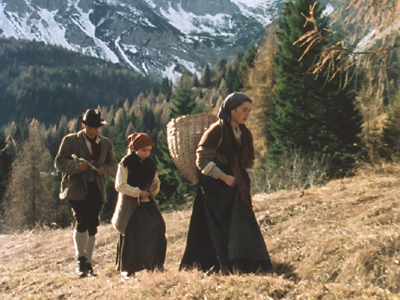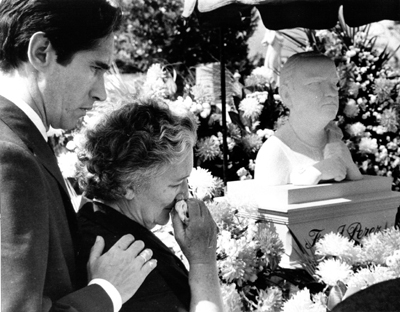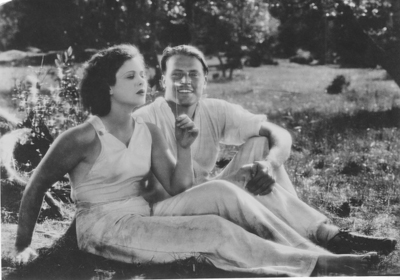Venice 2019: Repremieres
Tuesday | September 10, 2019 open printable version
open printable version
The Spider’s Strategem (1970).
Kristin here:
The policy at the Venice International Film Festival is to show only world premieres of films. Luckily that includes premieres of restored prints of classic films. These form a major thread in the program here, and this year had been particularly rich in older films that have been unavailable or available only in incomplete or poor prints. We have been catching up with some favorites and were introduced to unfamiliar ones.
The Spider’s Strategem (1970)
Back in the mid-1970s, David and I taught Bernardo Bertolucci’s film, which he made directly after the better-known The Conformist (also 1970). Thanks to the New Yorker print, we came to know it well, and when we wrote Film Art: An Introduction, an example of it went in and has stayed in. David analyzed the film’s storytelling principles at length in Narration in the Fiction Film.
The film came out in VHS versions in the US and UK, both out of print, but it never was released on DVD or Blu-ray. Now it returns in a stunning restoration from Fondazione Cineteca di Bologna and Massimo Sordella. (The restored version is out on Blu-ray in Japan, but without English subtitles.)
The plot involves a young man, Athos Magnani, who returns to the village where his father, who shares his name and appearance, gained a reputation as a bold leader of a small resistance group during the 1930s. He was also mysteriously murdered. The father’s mistress, Draifa, urges his son to stay and investigate the crime, and, it is hinted, to take his father’s place in her bed.
Young Magnani does investigate, but he quickly becomes uncertain as to which villagers were his father’s friends and which his enemies. He also finds himself targeted with threats of violence. Flashbacks mix scenes of past and present with no attempt to differentiate them via period props, changing ages, or stylistic contrasts. The ambiguities, which continue to the end, are not surprising, given that the literary source was a Jorge Luis Borges short story.
Whether or not one enjoys the teasing plot, the visuals are enough to provide delight. The cinematography was done by two major Italian cinematographers: Franco Di Giacomo (The Night of the Shooting Stars, Il Postino) and Vittorio Storaro, known for his bold use of color (Dick Tracy, Tucker: The Man and His Dream, and Tango). The result (see top) is like a blend of classical paintings and an Italian fruit stall.
Now all we need is a Blu-ray release worthy of the print shown here.
Maria Zef (1981)
This was Italian director Vittorio Cottafavi’s penultimate work, made after he has worked almost exclusively in television since the beginning of the 1960s. It has a pleasantly old-fashioned look, perhaps not too surprising in that Cottafavi says he conceived it in 1938, two years after the source novel appeared. He was not able to make it until 1981, when it was seen a project local to the Friuli region of northeastern Italy.
Some internet sources list it as a TV series, but IMDb and others treat it as a film. Certainly it looks like a film and seems to have no obvious pause points. But it was produced by RAI and was shot in the TV-friendly Academy ratio rather than the wider formats that were standard by the 1980s. (While I was watching it, I thought of it as a much earlier film and was surprised to find that it was made so late.)
Maria, an adolescent girl, is traveling with her irrepressible younger sister Rosute and her dying mother. They carry a cart full of domestic implements to sell. The two are taken in by their uncle, Barbe Zef, who made the spoons and other wooden housewares that the trio had been peddling. He’s a gruff fellow, and violent when drunk. Under the influence, he rapes Maria and tries to stifle her subsequent resentment as if his attack had been just a natural impulse.
The film was shot on location in the Italian Alps (above). The region of Friuli will be familiar to many film scholars and buffs who have traveled there for the “Giornate del Cinema Muto” silent-film festival in Pordenone.
The restoration was done by Rai Teche. With luck, the new print will travel abroad and introduce Cottafavi, an Italian favorite, to broader audiences.
[September 10: Thanks to blogger Manfred Polak for providing further information on Maria Zef. He provides a link to a brief piece on the film at the Cineteca de Friuli website. This piece (in Italian) says the film will play at the I Milleocchi festival in Trieste, 13-18 September 2019. The Cineteca also plans a DVD release with numerous supplements. Its earlier release of Vito Pandolfi’s Gli ultimi had optional English subtitles, so perhaps the Maria Zef DVD will as well.]
Mauri (“Life force,” 1988)
This restoration from the New Zealand Film Commission and Park Road Post Production should make available a nearly forgotten classic of New Zealand cinema. It remains the only New  Zealand feature with a Māori woman, Merata Mita, as sole director. (In 1972, To Love a Māori had been co-directed by the husband-wife team Raimi and Rudall Hayward.) Mita had previously made the first feature-length documentary by a Māori woman, Patu! (1983). Much of her career was devoted to documentary filmmaking.
Zealand feature with a Māori woman, Merata Mita, as sole director. (In 1972, To Love a Māori had been co-directed by the husband-wife team Raimi and Rudall Hayward.) Mita had previously made the first feature-length documentary by a Māori woman, Patu! (1983). Much of her career was devoted to documentary filmmaking.
The plot centers largely around an interracial love triangle. Māori woman Ramari is loved by Steve, a white farmer who was schooled alongside Māori children and retained Māori friends as an adult. His father, however, is a rabid and apparently crazy racist who tries a variety of pranks, some violent, to break up the match. Ramari loves a Māori man, Rewa, who harbors a dark secret that prevents him from marrying her.
This drama plays out against the intertwined doings of the family and circle of friends headed by the matriarch Kara. She tries to instill traditional values into her children, grandchildren, and the various troubled people she has treated as her own offspring. The film is set and shot in a tiny, declining village, Te Mata, in the East Cape area of the North Island, south of the now-thriving Hawke’s Bay winery region.
According to the biographical page linked above, “Mita said she had consciously rejected Pākehā traditions of storytelling and embraced a layered approach, in keeping with the strongly oral traditions of Māori. She told writer Cushla Parekowhai: “These are differences that Pākehā critics don’t even take into account when they’re analyzing the film.” Pākehā is the Māori word for white people.
There are rare films, and here I think of Charles Burnett’s To Sleep with Anger, that are entirely set in a specific non-white culture and make no attempt to explain that culture to a white audience. Clearly Mita was trying for the same approach. Her film met with some criticism for not following mainstream conventions of film narrative. Nevertheless, like To Sleep with Anger, Mauri draws in viewers with its drama and appealing characters. Today audiences with a greater openness to other cultures will most likely greet this restored version with greater sympathy and appreciation.
Death of a Bureaucrat (1966)
Tomás Gutiérrez Alea is undoubtedly Cuba’s most famous and revered director. Even those with the most passing knowledge of Cuban cinema will know such titles as Memories of Underdevelopment (1968) and Strawberry and Chocolate (1993). Death of a Bureaucrat is another familiar title, restored by the Academy Film Archive and the Cinemateca de Cuba. The screening was introduced by our old friend Joe Lindner, Preservation Officer at the Academy Archive.
The film is essentially a slapstick farce on a rather unlikely topic, the burial and reburial of the titular bureaucrat. He was a man who distinguished himself by inventing a machine to mass-produce the white busts of political leaders which stand in every government office in Communist countries (and which resemble the bust on the bureaucrat’s tombstone, above). The plot, however, is set off when it is discovered that as a tribute to such a genius, the dead man’s work card has been buried with him, and his widow needs it to receive her benefits.
The rest of the film is a series of escalating efforts by the man’s son to track down the exhumation order which the cemetery officials demand if they are to be able to rebury the body after the card is retrieved. Numerous stamps, signatures, and forms are required, all of which can only be provided by a single person–naturally different in each case. The hero becomes increasingly desperate and begins to try stealth, slipping into an office after closing hours and smuggling his father’s coffin into the graveyard to rebury it himself. All the while the grieving widow gathers all the ice her friends and neighbors can supply to prevent the body, kept at her house, from deteriorating.
The action is amusing enough, including one scene where a hearse is revealed to have a small plastic skeleton dangling from its rear-view mirror. The action does become somewhat repetitious and drawn-out, and one gets the feeling at times that the humor is perhaps aimed at an uneducated audience of workers and peasants, comparable to the Socialist Realism imposed upon filmmakers in the Soviet Union after the 1920s.
It’s interesting that such criticism of the workings of government would be permitted, and yet bureaucratic red tape seem to have been a somewhat safe target for Communist filmmakers, especially if presented as a sort of holdover of bourgeois practices. In the 1920s the Soviets had My Grandmother (Kote Mikaberidze, 1929) and The State Functionary (Ivan Pyriev, 1930), and Death of a Bureaucrat somewhat recalls them.
Extase (1933)
Each of the three years we have visited the Venice International Film Festival, there has been a preliminary evening where a restored early film has been shown. The first year saw the restored Rosita, the second Der Golem, both with orchestral accompaniment. This year there was an early Czech sound film, Gustav Machatý’s Ecstasy.
Having see the film only in the incomplete version that circulated in 16mm in the US for many years, I must say that I had not been impressed. The new restoration by the Národni filmový archiv, with much support from other archives, is a very different film indeed.
The story makes more sense now. It begins with the heroine, played by Hedy Kiesler-Lamarr (as she was then) as a young women who marries a wealthy older man. He turns out to have little interest in passionate love, and she is left on her own to be seduced by a young engineer working on a project near her husband’s estate. The film became famous for its scene of the heroine swimming nude, as well as her first, explicit for its day, love scene with the engineer.
The melodrama works its way out, with the rich man killing himself and the heroine, feeling guilty, leaving her lover. At this point, in the restored print, an abrupt switch to a lengthy sequence shows the engineer returning to work, with a joyous celebration of labor depicted in an imitation of Soviet films of the era. This incongruous ending to the plot comes quite unexpectedly, creating a film very different from the versions available hitherto.
Extase remains a less than wholly satisfactory film, but it now reveals its mixture of various influences of the era: the subjectivity of French Impressionism, the soft style of cinematography from the silent era, and in its ending, the propaganda and montage construction of Soviet cinema. Like Genina’s Prix de Beauté (1930), it’s an early-sound effort to preserve the aesthetics of mature silent cinema.
The evening definitely provided a new, startling version of a hitherto mutilated classic.
Thanks to Paolo Baratta and Alberto Barbera for another fine festival, and to Peter Cowie for the invitation for David to participate in the College Cinema program. We also appreciate the kind assistance of Michela Lazzarin and Jasna Zoranovich for helping us before and during our stay.
Our collaborator Jeff Smith provided a video analysis of another Alea film, Memories of Underdevelopment, for the Criterion Channel. He discusses it in this May blog post.
To go beyond our Venice 2019 blogs, check out our Instagram page.
September 10: Thanks to Hamish Ford and Lee Tsiantis for information concerning The Spider’s Strategem‘s releases on VHS and Japanese Blu-ray.
September 18, 2019: Thanks to Gareth McFeely for corrections on dates and spellings in the section on Mauri.
Mauri (1988).












